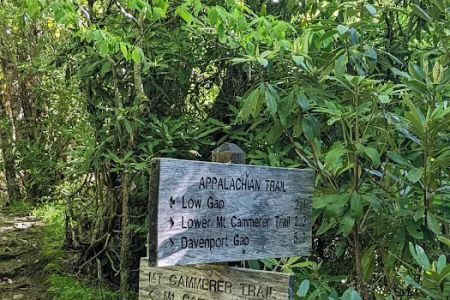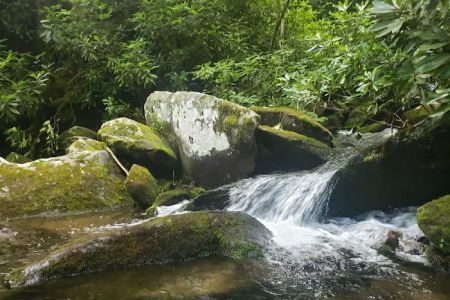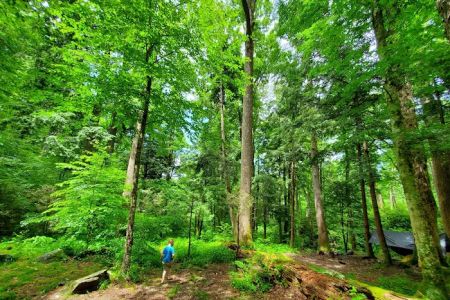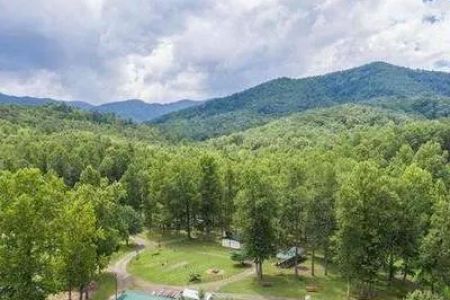Camel Gap
Camel Gap Overview
Rating
Address Waynesville, NC 28785, USA
Hours
Camel Gap Location & Map
North CarolinaHaywood CountyWaynesville
Camel Gap About
For North Carolina locals who live and breathe the call of the wild, particularly those drawn to the majestic Great Smoky Mountains, "Camel Gap" represents more than just a name on a map. While not a traditional campground with amenities, Camel Gap is a significant geographical feature and a key junction for hiking trails located deep within the Great Smoky Mountains National Park, accessible from the North Carolina side near Waynesville, NC (28785, USA). It embodies the essence of primitive backcountry exploration, offering a profound connection with nature for those willing to venture beyond paved roads and developed campgrounds.
Camel Gap itself is not a specific campground with designated sites in the conventional sense, but rather a gap in the mountains where several trails converge, including the Camel Gap Trail, and, crucially, its junction with the legendary Appalachian National Scenic Trail (AT). This makes it a vital point for backpackers, thru-hikers, and adventurous section hikers seeking an authentic wilderness experience. The surrounding area, particularly along the Camel Gap Trail itself, offers beautiful forest scenes, the soothing sounds of Big Creek, and opportunities for true primitive backcountry camping (where allowed by park regulations and with the necessary permits).
For North Carolina residents, understanding the nature of Camel Gap is key. This isn't a place you drive to and set up a tent beside your car. It demands a hike, often a strenuous one, but rewards adventurers with unparalleled solitude, pristine natural beauty, and the satisfaction of reaching a remote wilderness location. Reviews and trail descriptions consistently highlight the scenic journey to Camel Gap, describing it as a "gradual ascent up to its meeting with the Appalachian Trail," passing "large boulders and deep pools, rapidly flowing cataracts, and charming falls cloistered in luxuriant arbors of rhododendron." The area is also known for its "dramatic vistas and forest scenes, especially during the colorful fall months," making it a highly rewarding destination for those prepared for a backcountry trek.
This article will delve into what North Carolina locals can expect from a visit to Camel Gap, focusing on its challenging yet rewarding accessibility, the primitive "services" available in a backcountry setting, its natural features and highlights as a wilderness destination, and the critical information needed to plan a safe and responsible trip. Ultimately, we aim to demonstrate why Camel Gap is perfectly suited for those North Carolinians seeking a profound and authentic connection with the wild heart of the Great Smoky Mountains.
Camel Gap is located within the rugged and scenic Great Smoky Mountains National Park, in the North Carolina section. While the provided address of "Waynesville, NC 28785, USA" gives a general proximity, it is critical for North Carolina locals to understand that Camel Gap is a backcountry location, not accessible by car. It is a specific "gap" or low point in a ridge where several trails intersect, most notably the Camel Gap Trail and the Appalachian National Scenic Trail.
The primary access point for beginning a hike to Camel Gap from the North Carolina side is the Big Creek Trailhead, located near Waterville, NC (which is Exit 451 off Interstate 40). From this trailhead, hikers would typically follow the Big Creek Trail upstream. The Camel Gap Trail begins at the junction with the Big Creek Trail near the Upper Walnut Bottom Backcountry Campsite (#36). From this junction, the Camel Gap Trail gradually ascends approximately 4.7 miles to reach Camel Gap itself, where it meets the Appalachian Trail.
The journey to Camel Gap involves a significant and often strenuous hike with elevation gain. Hikers should be prepared for varying trail conditions, including potentially rocky sections, roots, and stream crossings. While the "gradual ascent" of the Camel Gap Trail is often noted as "hiker friendly" due to its origin as an old logging grade, it still requires good physical conditioning and proper hiking gear.
For North Carolina residents, towns like Waynesville, Asheville, or even Knoxville (in Tennessee, but close to the Big Creek entrance) serve as good gateway communities for supplies and lodging before embarking on a backcountry trip. However, once you begin your hike from the Big Creek Trailhead, you are fully immersed in the wilderness. Cell phone service is typically nonexistent or extremely unreliable in this remote area, emphasizing the need for thorough preparation, self-sufficiency, and reliance on maps and navigation skills. Accessibility to Camel Gap is solely by foot, offering a true wilderness experience away from the crowds, a significant draw for many North Carolina outdoor enthusiasts.
As a backcountry location within a national park, Camel Gap itself does not offer "services" in the traditional sense of a developed campground. It is a natural convergence point of trails, and any "services" available would be rudimentary and focused solely on supporting primitive backcountry travel and safety. This is not a place with amenities like restrooms, picnic tables, or designated campsites.
Any "services" near Camel Gap would primarily be found at designated backcountry campsites or shelters along the intersecting trails, for which hikers must obtain a permit in advance. For instance:
- Backcountry Camping (Permit Required): While Camel Gap itself is a trail junction, primitive backcountry camping is generally permitted in the Great Smoky Mountains National Park only at designated backcountry campsites (e.g., Backcountry Campsite #36 or #37 near the start of the Camel Gap Trail) or within designated shelters (like Cosby Knob Shelter, which is accessible via the Appalachian Trail from Camel Gap). These sites, if permitted, would offer:
- Designated tent pads/areas (primitive, often just cleared ground).
- A natural water source nearby (requiring filtration/purification).
- A privy (outhouse) for waste disposal.
- Bear cables or poles for proper food storage.
- Trail Information: Signage at the Camel Gap junction would provide directional information for the intersecting trails (Appalachian Trail, Camel Gap Trail, etc.), possibly indicating mileage to the next shelter or feature.
- Natural Water Sources: Along the Camel Gap Trail and at Camel Gap itself, there may be natural streams or springs. However, as noted, all water must be treated before consumption.
It is crucial to re-emphasize that Camel Gap is a wilderness area. There is no staff on site, no trash collection (all trash must be packed out), no electricity, no running water (beyond natural sources), and no cell service. Hikers must be entirely self-sufficient, carrying all necessary gear, food, and water treatment supplies, and adhering strictly to Leave No Trace principles. Any overnight stay in the Great Smoky Mountains backcountry requires a mandatory permit obtained in advance from the National Park Service.
Camel Gap, though not a typical campground, offers a compelling set of features and highlights that make it a truly special destination for North Carolina locals seeking a deep dive into the wilderness of the Great Smoky Mountains National Park. Its allure lies in its natural splendor and its role as a nexus for significant trails.
- Strategic Trail Junction: A primary highlight is its location as a key junction for the Appalachian National Scenic Trail (AT) and the Camel Gap Trail. This makes it an important waypoint for thru-hikers and an excellent destination for North Carolinians looking to complete a challenging section hike of the AT or explore connecting trails.
- Authentic Backcountry Experience: Camel Gap provides an authentic, primitive backcountry experience. Far removed from roads and developed facilities, it offers true solitude and an opportunity to immerse oneself completely in the sights, sounds, and rhythms of the wilderness. This is perfect for those seeking to escape urban noise and light pollution.
- Scenic Trail Journey: The hike to Camel Gap, particularly via the Camel Gap Trail, is a highlight in itself. Descriptions often mention its "gradual climb" along an old logging grade, passing by "large boulders and deep pools, rapidly flowing cataracts, and charming falls cloistered in luxuriant arbors of rhododendron." This trail offers a beautiful, less steep ascent compared to some other routes in the Smokies.
- Beautiful Creek Environment: The Camel Gap Trail follows Big Creek for much of its lower section, providing constant access to the tranquil sounds of flowing water, picturesque stream views, and potentially opportunities to spot Smoky Mountain trout in its clear waters.
- Wildlife Viewing Opportunities: Being deep within the Great Smoky Mountains National Park, the area around Camel Gap is rich in wildlife. Hikers have excellent chances to observe diverse bird species, deer, and potentially black bears in their natural habitat, adding an exciting dimension to the wilderness experience.
- Historical Logging Remnants: The Camel Gap Trail's origins as an old logging grade means hikers might encounter subtle historical remnants of the logging era, adding an interesting layer to the natural landscape.
- Stunning Seasonal Scenery: The natural beauty of the area is particularly pronounced during the vibrant fall months, when the foliage of maples, oaks, and other trees transforms the landscape into a tapestry of color, making the hike to Camel Gap exceptionally picturesque.
- Remote Access to the AT: For section hikers from North Carolina, Camel Gap provides a relatively accessible (though still challenging) point to join the Appalachian Trail for southbound or northbound adventures, connecting them to a larger hiking network.
As Camel Gap is a natural geographical feature and a backcountry access point within the Great Smoky Mountains National Park, a federally managed land, it does not offer "promotions or special offers" in the commercial sense. There are no discounted rates, seasonal specials, or loyalty programs associated with visiting or camping near Camel Gap.
The National Park Service operates on a different model, where any fees collected are typically fixed and contribute directly to the management, maintenance, and protection of the park's resources and visitor services.
However, it is crucial for North Carolina locals planning a trip to understand the following, which are the essential "terms" or requirements for visiting and, if applicable, camping in the vicinity of Camel Gap:
- Backcountry Permit Requirement: Any overnight stay in the backcountry of the Great Smoky Mountains National Park, including at designated backcountry campsites or shelters accessible from Camel Gap, requires a mandatory backcountry permit. There is a fee associated with this permit (e.g., typically around $8 per person per night, with a trip maximum of $40 per person as of recent information). This fee supports the park's backcountry management, including trail maintenance, privy servicing, and wildlife management efforts.
- Advance Reservations: Backcountry permits, especially for popular shelters or campsites, must be reserved in advance through the park's online backcountry reservation system (usually via Recreation.gov). This is vital to secure your overnight stay and avoid overcrowding.
- No Park Entrance Fee: The Great Smoky Mountains National Park is unique in that it does not have a mandatory entrance fee to drive through its main roads. This means that access to the Big Creek Trailhead, and thus the starting point for your hike to Camel Gap, does not incur a separate entrance charge.
- Seasonal Considerations: While the trails leading to Camel Gap are generally open year-round, conditions vary greatly by season. Winter travel can be extremely challenging due to snow and ice, requiring advanced skills and gear. The "offer" is its availability during prime hiking seasons (spring through fall) when conditions are more favorable.
North Carolina locals should always consult the official Great Smoky Mountains National Park website (NPS.gov/grsm) or Recreation.gov for the most current information on backcountry permits, fees, regulations, and trail conditions before planning a trip to Camel Gap.
Camel Gap, being a geographical point and trail junction deep within the wilderness of the Great Smoky Mountains National Park, does not have its own direct contact number in the way a commercial business would. The provided address, "Waynesville, NC 28785, USA," indicates its general location within the national park's North Carolina side.
The primary phone number provided for the Great Smoky Mountains National Park is (865) 436-1200 (or +1 865-436-1200). This is the general information line for the park headquarters in Gatlinburg, Tennessee. While this number can provide broad park information, specific inquiries regarding backcountry regulations, permits, and detailed trail conditions for Camel Gap should be directed through official park channels designed for backcountry users.
- Address: Appalachian National Scenic Trail, Waynesville, NC 28785, USA (This broadly defines its location in the backcountry. Hikers rely on detailed topographic maps and GPS coordinates.)
- General Park Information Phone: (865) 436-1200 or +1 865-436-1200. Call this number for general questions about park policies, safety guidelines, and current alerts, though they may direct you to online resources for specific backcountry planning.
The most crucial resources for North Carolina locals planning a visit to Camel Gap are:
- Great Smoky Mountains National Park Backcountry Information and Permit System: This is primarily accessed through Recreation.gov. It is essential for obtaining the required backcountry permit for any overnight stays and for finding detailed information on designated campsites and shelters near Camel Gap.
- Official Great Smoky Mountains National Park Website (NPS.gov/grsm): This website is the authoritative source for comprehensive information on backcountry regulations, trail descriptions, bear safety protocols, current cautions and closures (e.g., trail damage, bear activity), and essential packing lists.
- Appalachian Trail Conservancy (ATC) Website: For those hiking segments of the AT that pass through Camel Gap, the ATC website provides invaluable resources on trail conditions, shelters, and guidance for long-distance hikers.
- Local Park Ranger Stations: While you can't call Camel Gap directly, speaking with a ranger at a park visitor center (e.g., Oconaluftee Visitor Center in Cherokee, NC, or the Big Creek Ranger Station near the trailhead) can provide real-time updates and expert advice on conditions specific to the area.
It is important to remember that cell service is unreliable in the remote backcountry, so hikers should not rely on phone communication once on the trail.
For North Carolina locals seeking a true wilderness adventure, a profound connection with nature, and the challenge of backcountry exploration, Camel Gap stands out as an exceptionally suitable destination. It offers an authentic, unvarnished experience of the Great Smoky Mountains National Park, far removed from the typical tourist crowds.
Its suitability stems from several key factors. First and foremost, Camel Gap provides direct access to the legendary Appalachian National Scenic Trail right here in our backyard. For North Carolinians who aspire to hike a section of this iconic trail, or simply wish to experience the raw beauty of the Smokies on a multi-day backpacking trip, Camel Gap serves as a vital and rewarding waypoint. Its accessibility via a major interstate (I-40) to the Big Creek Trailhead makes the initial journey manageable, before transitioning into a truly remote foot-powered expedition.
Secondly, Camel Gap caters to those who prioritize solitude and an immersive outdoor experience. This isn't a place with amenities like showers or paved sites; it's about embracing the simplicity of primitive camping, relying on one's own skills and gear, and appreciating the sounds of the forest and the majesty of the mountains. The scenic Camel Gap Trail leading to this junction offers a beautiful journey through lush forests, past cascading creeks, and provides opportunities for stunning fall foliage viewing, enriching the entire experience.
Furthermore, the chance for wildlife encounters, a feature often noted by those who visit the area, adds an exciting and memorable dimension to the trip. For locals, this means having unparalleled opportunities to observe the diverse ecosystems of the Great Smoky Mountains firsthand. Successfully navigating to and spending time at Camel Gap also offers a deep sense of accomplishment and self-reliance, fostering a stronger appreciation for conservation and Leave No Trace principles.
While it demands preparation, a backcountry permit, and a willingness to embrace the wild, for adventurous North Carolina locals, Camel Gap is more than just a place on a map. It's a gateway to an unforgettable wilderness journey, an opportunity to truly disconnect, and a chance to experience the raw, untamed beauty of the Great Smoky Mountains in its purest form.
Customer Reviews
More Campsites Nearby

Cosby Knob Shelter
Appalachian National Scenic Trail, Waynesville, NC 28785, USA

Cosby Campground
127 Cosby Entrance Rd, Cosby, TN 37722, USA

Lower Walnut Bottom Campsite 37
Waynesville, NC 28785, USA

Sunup Knob
Waynesville, NC 28785, USA

Backcountry Campsite #36
Waynesville, NC 28785, USA

Backcountry Campsite #29
Cosby, TN 37722, USA

Backcountry Campsite #34
Cosby, TN 37722, USA

Backcountry Campsite #35
Cosby, TN 37722, USA

Cosby Run CAMPGROUND/ RV PARK
311 south hwy 32, Cosby, TN 37722, USA
